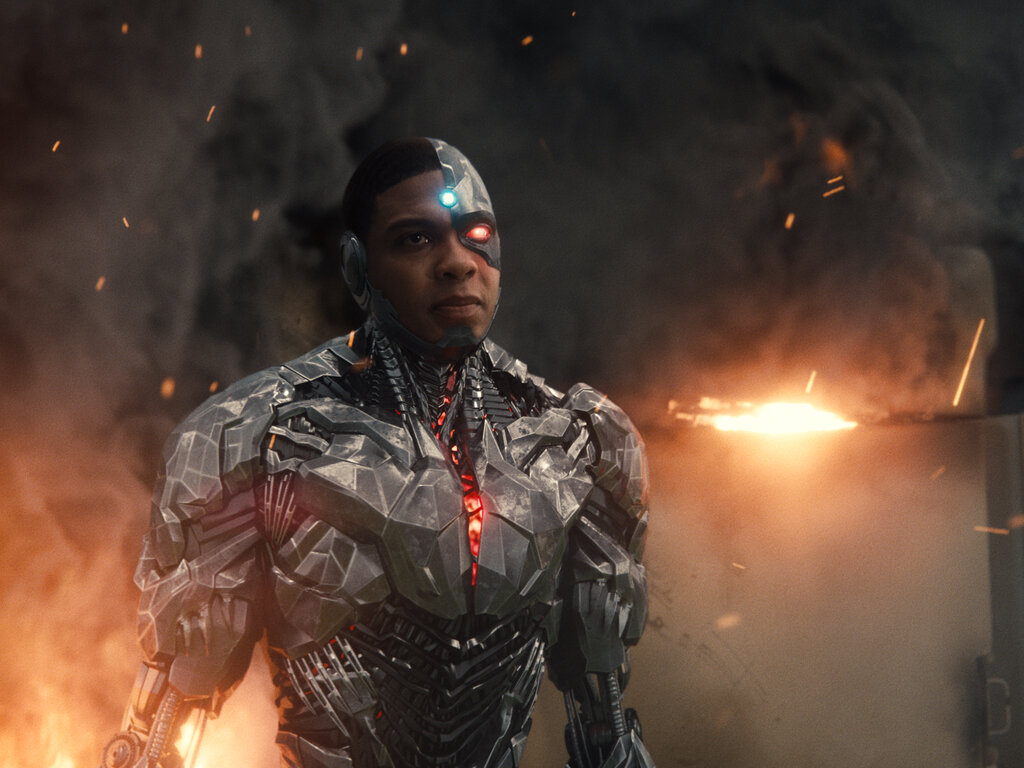Rebecca’s Take
When Zack Snyder left the superhero 2017 teamup “Justice League” due to a family tragedy, it changed the trajectory of the troubled blockbuster’s legacy and the direction of DC Comics’ Extended Universe. The polarizing architect of the DCEU saw his fingerprints swept away from the final product as Warner Bros. brought in Joss Whedon to finish the film. The resulting mishmash underperformed at the box office, drawing mixed reviews as the contrasting styles of its two directors battled it out onscreen. The film’s perceived failure spurred the DCEU to switch from interconnected movies to more standalone films.
In the years since, Snyder fans have called out for a fabled “Snyder Cut,” demanding to see the director’s ultimate vision for his third film in the DCEU after 2013’s “Man of Steel” and 2016’s “Batman v Superman: Dawn of Justice” charted a dark and gritty course. In 2021, fans got their wish.
“Zack Snyder’s Justice League” is the version we should have gotten in 2017. With Warner Bros.’ backing, Snyder brings his magnificent vision to life, finishing the film on his own terms. The director’s dazzling four-hour-long opus, now streaming on HBO Max, is far superior to the theatrical cut, improving on the original film in every conceivable way.
The sprawling film brings together the superheroes already established in the DCEU – billionaire crimefighter Batman/Bruce Wayne (Ben Affleck), Amazon warrior Wonder Woman/Diana Prince (Gal Gadot) and the recently deceased Superman/Clark Kent (Henry Cavill) – and introduces fresh faces into the fold. There’s Cyborg/Victor Stone (Ray Fisher), who was left half-human, half-machine after a tragic accident; Barry Allen/The Flash (Ezra Miller), the fastest man alive; and Arthur Curry/Aquaman (Jason Momoa), a part-man, part-Atlantean who struggles to find his place in both worlds (and got his own standalone movie in 2018). The six come together to save the world from Steppenwolf (Ciaran Hinds), an alien goon seeking to serve up Planet Earth to his disgruntled master Darkseid (voiced by Ray Porter).
Back in 2017, I initially liked the “Justice League” theatrical cut. I’ve watched it many times and even own the Blu-Ray. I ranked my affinity for its characters and light-hearted jokes above a choppy film that felt like it was missing parts (the film was edited down to two hours, according to a studio mandate). But after watching “Zack Synder’s Justice League,” I realized I should have expected more from the original. Seeing the Snyder cut opened my eyes to how lacking and fractured the theatrical cut is.
Snyder was forced to step away from the original project after the suicide of his daughter Autumn. With the reins back in the director’s hands, “Zack Snyder’s Justice League” retains the major plot points and battles from the original film but completely retools its execution, resulting in a more cohesive film with a consistent tone.
Whedon increased the humor in the theatrical cut, leading to some forced scenes that felt at odds with Snyder’s grounded vision. This caused the 2017 version to bounce around from a light atmosphere to a dark one at any given moment. Here, Snyder smooths out the tone from the get-go. The film immediately establishes that its heroes are reeling from Superman’s death while sensing a dangerous threat on the horizon.
The first 15 minutes alone create a masterful introduction that ties together the main characters, their motivations and the setup for the villains’ plan that puts Whedon’s uneven prologue to shame. Snyder’s cut adopts a melancholy tone, punctuated by moments of humor that allow its audience to breathe. The somber atmosphere is enhanced for the better by its new score and soundtrack, with mellow strains and folksy tracks that let hope shine through. Tom Holkenborg completely rescored the film, taking over from Danny Elfman, the original film’s composer.
Following a logical throughline, “Zack Snyder’s Justice League” takes the time to introduce its superheroes and expand their character development. This version lovingly sets up the team dynamic, focusing on its heroes’ rescue instincts to bring them together instead of their differences tearing them apart, as in the original film. The film serves as a reminder of how well-cast the DC’s heroes are, including the sarcastic and able-bodied Affleck, whose time in the role of Batman may be limited.
In one of the most shocking omissions from the original, the Snyder cut restores Cyborg’s entire storyline. We see the heartbreaking loss of his mother (Karen Bryson); more of Cyborg’s strained relationship with his father, Silas (Joe Morton); and a moving scene that depicts Victor’s desire to help the helpless. All of these scenes are essential to understanding Fisher’s portrayal of the character, but were cut out or minimized in the original. The extra footage made me like Cyborg more than I already did.
The film also fleshes out its other heroes. As the Flash, Barry receives a whole new introduction. In the eye-popping sequence, Barry shows off his lightning-fast speed as well as his awkward sense of humor, an endearing personality trait. One thing Snyder’s version leaves out that I missed from the original was a pep talk Batman gives Barry before their first major battle. But the new intro renders the line of dialogue as moot. The blockbuster’s jaw-dropping finale also reveals Barry’s weaknesses as he must overcome them to reach the full scope of his power.
Despite having two solo movies, Gadot’s Wonder Woman benefits from even more screen time as the mighty and caring Diana. Gadot shines in an extended sequence of a bank heist, connecting with and encouraging a young girl, as well as capably holding her own against the relentless Steppenwolf. The Snyder cut thankfully eliminates scenes that objectified the Amazon princess in the original film, including an uncomfortable shot where the camera focuses on the back of Gadot’s rear in tight leather pants.
The opus restores Snyder’s vision for the resurrection of Cavill’s Superman, bringing back the Man of Steel in the fan-favorite black suit. The charismatic Cavill is a joy to behold as the character comes full circle, making peace with his purpose, joining the other superheroes and reuniting with his true love, Lois Lane (Amy Adams). Even Lois receives a revamped storyline here, following her own journey as she struggles with her grief over Clark’s death.
The Snyder cut also gives more time to its villains. The CGI for Hinds’ Steppenwolf looks sharper than in the original. Darkseid finally comes to play after being referenced in “Batman v Superman.” Though his screen time is limited, the big bad finds redemption after being completely cut out of the 2017 “Justice League.” And Jared Leto’s controversial Joker, who did not appear in the original, is a welcome addition. The actor’s performance as Batman’s nemesis is better here than in the entirety of 2016’s “Suicide Squad.”
“Zack Snyder’s Justice League” is more complete, but the revamp is not without its flaws. Its massive four-hour runtime can be off-putting to viewers. The film is divided into six parts, including a prologue and an epilogue. But the format benefits the pacing of the film, making it digestible. The breaks make it easy for audiences to stop and start the film over multiple sittings. I watched the film in three parts, which worked for me and my schedule.
The film starts to feel its length in the epilogue. Snyder adds a “Knightmare” sequence – a dream of Batman’s that hints at the future for the DCEU – which goes on far too long. The scene, though it pays off a similar sequence in “Batman v Superman,” feels indulgent, dragging out the film’s ending unnecessarily.
Though the film excels at explaining how its many moving parts work together, the Synder cut relies on a lot of exposition. After four hours, audiences will probably know too much about the “mother boxes,” the film’s MacGuffin that Steppenwolf needs to deliver Earth to Darkseid.
In a once-in-a-lifetime opportunity, Zack Snyder achieves his complete vision for “Justice League,” getting a unique second chance after the heartbreak of family tragedy. With a consistent tone, cohesive storytelling and more character development, the redo surpasses the scattered original without question. Though the film’s runtime is long, its format is well-suited to stream on HBO Max.
The transformative film now ranks among the DCEU’s best, which begs the question of how the cinematic universe will proceed. “Zack Snyder’s Justice League” not only brings justice to the persistent fans who called for it, but to the architect who saw what the future of the DCEU could be.
4 out of 5 stars

Ray Fisher as Cyborg in “Zack Snyder’s Justice League.” (HBO Max via AP)
Joe’s Take
Fans of the DC Extended Universe willed “Zack Snyder’s Justice League” into existence. It took four years, but the polarizing director finally realized his vision of the film. Snyder left the movie’s original production in 2017 when his daughter Autumn committed suicide, and Joss Whedon stepped in to complete it. Reshoots and studio interference cut the 2017 film to two hours and created a tonal mess. My official review of the original was, “I didn’t hate it.”
Somehow, Snyder’s cut came to life, and I dreaded the potential of watching this movie a second time. I didn’t want it to happen. Every post I saw on Instagram about the film, I commented, “Why is this happening?” I didn’t believe in Snyder, despite my respect for him. I didn’t believe he could make this bad movie good.
Well, I was wrong.
The director’s cut fixes tonal issues and adds backstory to make “Justice League” a much better film.
The biggest difference and best part of the new film was the backstory and arc of Victor Stone/Cyborg (Ray Fisher). The Whedon version gave him no backstory. I understand the studio wanted a two-hour movie, but not identifying the best part of the film and simply cutting it is inexcusable. The DCEU’s biggest problem was always patience. The Marvel Cinematic Universe created individual films before the team-up “Avengers” movies to establish the backstories for their characters. The DCEU rushed to the team-up films without establishing characters’ backstories. I understand Warner Bros. wanted to strike while the iron was hot in the superhero genre, but it was too short-sighted to realize comic book movies aren’t going anywhere and audiences will see good solo films (such as “Wonder Woman” and even “Aquaman”).
Cyborg proves the heart of the film, while in Whedon’s version he was just there. The backstory with his parents and arc of his relationship with his father make for some heartfelt and emotional moments that astronomically improve the film. I could not believe watching this cut that the 2017 film didn’t include any of it. I was stunned.
Also, the tonal issue is completely solved. Snyder created a cohesive film, while it’s clear in the 2017 movie that there were two visions at work. It’s no longer quippy. It instead matches the tone of the previous films. It’s more serious, but not to the extent that it’s grim.
Snyder’s cut builds off the heart of Cyborg’s story with an improved scene at Themyscira. In the 2017 film, I never understood why it was such an easy decision for Queen Hippolyta (Connie Nielsen) to seal off where one of the mother boxes was held, essentially killing her people. In Snyder’s cut, Hippolyta only sealed the area as a last resort. She did everything she could before that and didn’t make that impossible decision before her troops told her to do it. The pain on her face as the structure collapsed proved much more powerful and made much more sense. Speaking of the Amazons, this film has more Wonder Woman/Diana Prince (Gal Gadot), which is a huge positive as she is the best character in the DCEU. Things like that allowed the viewer to invest more in the movie.
I was happy to see the film cut the Bruce Wayne/Batman (Ben Affleck) is old plotline. One scene they shouldn’t have cut was the pep talk Batman gives Barry Allen/The Flash (Ezra Miller) before his first fight. It made sense that he needed it because he’s a kid. Overall, I did like The Flash’s arc better, but having that pep talk would have made the later scenes with him even more powerful.
I feel like people were excited about Darkseid, but it was clear to me that he was just going to be the Thanos of this universe and doesn’t really do much in the film. Despite Steppenwolf’s much improved look, his character is still very much the same. It reveals that he betrayed Darkseid and he’s trying to repay his debt. However, the film fails to tell the audience how he betrayed him.
It goes without saying, but this movie is way too long. At four hours, the film includes six parts and an epilogue. The movie could easily be a much more manageable three hours. The epilogue proves unnecessary with a Batman dream sequence that is out of place and mostly an excuse to get Joker (Jared Leto) in the movie. Snyder’s cut also tries to shoe-horn in another character who doesn’t fit into the film. The movie also had a lot of slow motion, which tends to accompany a Snyder film.
Superman’s change to the dark suit made no sense to me. I’m sure fans understand it, but the red cape and lighter blue original suit would have made more sense to the film. He is supposed to bring hope to the final battle and he is the beacon of light that inspires and completes the Justice League. Instead he flies in with his dark, colorless suit.
In the end, “Zack Snyder’s Justice League” still has issues, but the director’s cut drastically improves on the Whedon version with good storytelling, a cohesive tone and strong character development.
Although I was against the creation of this director’s cut, I’m happy Snyder realized his vision. Some things go beyond a film’s quality and when a director dedicates a film to his daughter and helps suicide prevention through the making of that movie, you have to take a step back and applaud. Many filmmakers have the right to realize their visions, and a lot of the time they are unable to do so. Snyder earned that right and created something good, while helping people around the world. This director’s cut wasn’t for me. It was for the fans. It was for Autumn. It was for the millions of people struggling with depression and suicidal thoughts. My score will be far from perfect, but that doesn’t mean I don’t admire what this film accomplished.
3.5 out of 5 stars

Rebecca Kivak and Joe Baress write about movies for Take 2 blog. Together, they review current flicks and offer their insights into the latest movie news. Rebecca is a copy editor and page designer at The Times-Tribune. She started her career with Times-Shamrock Newspapers in 2005 and has won several professional journalism awards for page design and headline writing. She also covers NASCAR races from Pocono Raceway. Contact: rkivak@timesshamrock.com; 570-348-9100 x5126; @TTRebeccaKivak




